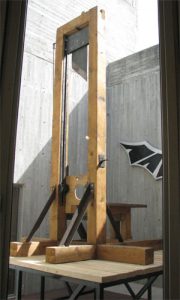Joshua Simon, the Curator of the Herzliya Biennial, wrote back then: “The technology of the beheading machine fit into the dynamics of the Revolution, and its egalitarian public violence was considered quick and painless. Once the reign of terror was introduced, and the members of the old monarchic regime were executed, followed by the enemies of the Revolution and even its procreators, the Revolution was deemed self-contradictory-from an inspiring call for liberation it ostensibly transformed into a systematic killing machine. At the same time, however … the guillotine expresses the radical democracy offered by the Revolution. The guillotine is a machine of intolerance toward the stranglehold by any ruling class whatsoever. While these constantly struggle against freedom, equality and brotherhood in order to establish their authority, the guillotine of the French Revolution always undermines any elite-based form of government. Ariel Kleiner’s guillotine enables one to imagine true democracy, where true rule of all citizens is possible.”
Presentation of the guillotine, towering on a wooden platform in a central Herzliya street above the square, garnered extensive public response. Its installation in the public sphere offered passersby an unexpected confrontation with a charged, violent image which elicited questions about the line between art and life-it was not clear whether this was the décor for a historical movie, a terrifying comeback of the execution mechanism, or an art object. One must bear in mind that today, not far away from here, in our region, public executions are still carried out in the city square (albeit by hanging, rather than by guillotine). The detached, elusive apparition of the guillotine in a city in Israel 2007 may in itself be considered the triumph of democracy, in which a functioning guillotine may be featured as an art object, independent of its use. At the same time, the guillotine, when operated in the name of noble causes, may also invoke questions about the cycles of violence.
With its shift from the public space to the museum interior, the broader context changes as well, and the guillotine must confront the historical aspect forced on it by the museum. The viewer, encountering the guillotine installed behind the glass windows in an intermediate museum space, faces an object whose origin and authentic status are obscure. The interpretation and emotional baggage applied to the guillotine are anchored, to a great extent, in the question regarding the object’s origin: Are we facing an object with a bloody history, one which carries an uncanny reveling on the safe proximity to bloodshed from another era, or is it a fictive work of art, a morbid reconstruction of a death machine as an aesthetic sculpture standing on a pedestal.
Less Reading...
